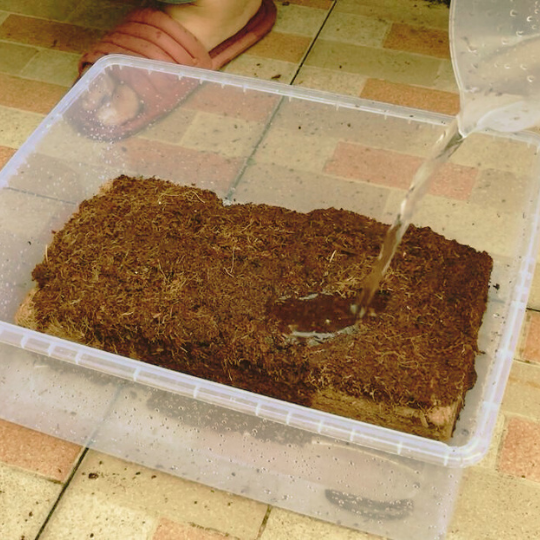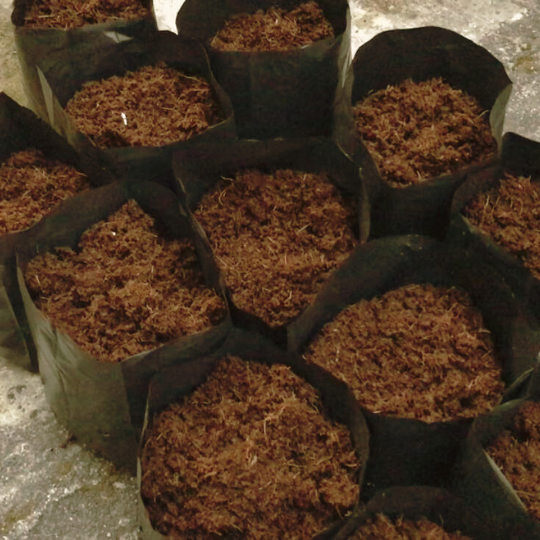Coco coir vs Coco peat mushroom – In the world of mushroom cultivation, the choice between coco coir and cocopeat, made from pure coconut husks, coconut husk fibers, is a critical one. Both substrates offer unique benefits for growing mushrooms, but understanding their differences is key to successful cultivation. Coco coir, derived from coconut husks, provides excellent water retention and aeration, while coco peat, a byproduct of coir production, offers high water-holding capacity. This comparison dives deep into the characteristics of these two substrates, helping you make an informed decision for your mushroom growing endeavours.

Understanding Coco Coir and Coco Peat
What is Coco Coir
Coco coir, also referred to as coir peat, is a fantastic growing medium made from the fibrous husk of coconuts. This natural material is a popular choice among gardeners and horticulturists due to its numerous benefits for plant growth. When it comes to nurturing your plants, coco coir acts like a superhero, providing essential support and nourishment.
One of the key advantages of using coco coir is its excellent water retention capabilities. Unlike traditional soil, coco coir can hold moisture exceptionally well, ensuring that your plants receive a steady supply of water without becoming waterlogged. This feature makes it an ideal choice for those looking to maintain optimal hydration levels for their plants.
Moreover, coco coir is known for its ability to improve aeration in the root zone. The fibrous structure of this material creates air pockets within the growing medium, allowing oxygen to reach the roots more effectively. This enhanced aeration promotes healthy root development and helps prevent issues such as root rot. In addition to its water retention and aeration properties, coco coir is also environmentally friendly and sustainable. Since it is derived from coconut husks, which are a byproduct of the coconut industry, using coco coir helps reduce waste and supports eco-friendly gardening practices.
Overall, whether you are a seasoned gardener or just starting out, incorporating coco coir into your gardening routine can significantly benefit the health and growth of your plants. With its unique properties and eco-friendly nature, coco coir continues to be a top choice for plant enthusiasts looking to maximize their gardening success.
What is Coco Peat
Coco peat, or coir pith peat, is an eco-friendly material derived from coconut husks. It serves as a soil conditioner and growing medium in gardening and agriculture. One of its primary benefits is improved soil structure, enhancing aeration and water retention, which reduces the risk of waterlogging and compaction that can impede root growth.
Coco peat’s fibrous texture promotes optimal root penetration, preventing soil compaction and fostering healthy root systems. It boasts high water retention, allowing for less frequent watering and stable moisture levels, making it ideal for plants needing consistent moisture, such as mushrooms. Compared to other growing mediums like coco coir, coco peat has a finer texture, further enhancing its moisture retention capacity.
Coco peat is a valuable resource for improving soil quality and promoting plant growth, making it an excellent choice for various gardening applications. Incorporating it into gardening practices can lead to healthier, more productive plants.

Key Differences
Raw Material
- Coco coir comes from coconut husk fibres.
- Coco peat refers to the pith, dust, or ground-up husks.
Water Retention
- Coco coir has excellent water retention properties.
- Coco peat, also known as pith, absorbs water rapidly but can become compacted over time.
Nutritional Value
- Coco coir is nutrient-rich, promoting plant growth.
- Coco peat has fewer nutrients compared to coco coir.
pH Levels
- Coco coir has a neutral pH, ideal for most plants.
- Coco peat, also known as pith, tends to be slightly acidic, requiring additional pH adjustments for certain plants.
Common Features
Coco coir and coco peat share several common features that make them popular choices for gardeners and farmers alike. Both are organic, renewable, and environmentally friendly alternatives to traditional soil mediums. Their sustainable properties and versatility make them ideal for improving garden health and promoting environmental sustainability. Whether you choose coco coir or coco peat, you can feel confident that you are making a positive impact on the environment while enhancing the growth of your plants.
Suitability for Mushroom Cultivation
Water Management
Coco coir, being a byproduct of coconut husks, retains moisture well, aiding in maintaining optimal hydration levels for mushroom growth. In contrast, coco peat requires frequent watering due to its high drainage rate.
Nutritional Aspects
- Coco coir offers a sterile growing medium, reducing the risk of contamination.
- However, coco peat provides minimal nutrients, necessitating supplementation for mushroom cultivation.
pH Level Impact
- Coco coir has a neutral pH, creating an ideal environment for mushrooms.
- Conversely, coco peat tends to be more acidic, requiring pH adjustments for optimal growth.
Texture and Appearance
- The fibrous texture of coco coir promotes aeration and prevents compaction.
- On the other hand, coco peat is finer and denser, potentially affecting oxygen availability for mushrooms.

Preparation Methods for Coco Coir vs Coco Peat Mushroom Substrates
Preparing Coco Coir
Coco coir, derived from coconut husks, is a popular substrate for mushroom cultivation. To prepare it, hydrate the coir by soaking it in water until it expands. Next, drain excess water and fluff the coir to create an aerated texture. Ensure the moisture level is optimal before use.
Preparing Coco Peat
Coco peat, another excellent substrate choice, requires specific preparation steps. Begin by soaking the peat in water to expand its volume. After that, squeeze out excess water and break any clumps to achieve a uniform consistency. Maintain the moisture content at an appropriate level throughout the process.
Pasteurisation Steps
Pasteurisation is crucial to eliminate harmful pathogens in substrates. Heat the prepared coco coir or coco peat to around 60-70°C for a few hours. This process helps create a sterile environment for mushroom growth while retaining essential nutrients in the substrate.
Inoculation Tips
When inoculating your substrate with mushroom spawn, ensure cleanliness and sterility. Use a glove box or work in a clean environment to prevent contamination. Carefully distribute the spawn throughout the substrate for even colonization.
Advantages and Disadvantages
Benefits of Coco Coir
Coco coir, derived from coconut husks, retains moisture well, promoting healthy mushroom growth. It is environmentally friendly and sustainable.
- Retains moisture effectively
- Environmentally friendly and sustainable
Benefits of Coco Peat
Coco peat, a byproduct of coco coir production, is lightweight and has excellent water retention capabilities, aiding mushroom cultivation.
- Lightweight material
- Excellent water retention properties
Drawbacks of Coco Coir
Despite its benefits, coco coir can be expensive, especially when used in large quantities for mushroom cultivation. It also decomposes slowly.
- Expensive compared to other substrates
- Slow decomposition rate
Drawbacks of Coco Peat
Coco peat may sometimes contain high salt levels, which can be detrimental to mushroom growth. It can also be difficult to rehydrate after drying out.
- Potential high salt content
- Challenging rehydration process

Summary
In understanding the differences between coco coir and coco peat for mushroom cultivation, you’ve delved into their unique characteristics and suitability as substrates. By exploring preparation methods and weighing the advantages against the disadvantages, you now possess a comprehensive view of these materials. To excel in your mushroom growing endeavours, choose wisely based on your specific needs and preferences. Experiment with different methods to find what works best for you and watch your mushroom cultivation thrive.
Frequently Asked Questions
What is the difference between Coco Coir and Coco Peat?
Coco coir is fibrous material from coconut husks, while coco peat is the fine material. Coir has better aeration, drainage, and water retention properties, suitable for mushroom cultivation. Peat is finer and more compact, requiring careful handling to avoid compaction.
Which is more suitable for Mushroom Cultivation: Coco Coir or Coco Peat?
Coco coir is preferred for mushroom cultivation due to its excellent water retention and aeration properties. It provides a conducive environment for mycelium growth and mushroom fruiting. Coco peat can be used as a supplement in mushroom substrate mixes.
How should I prepare substrates using Coco Coir or Coco Peat for mushrooms?
For coco coir, hydrate the coir brick with water until it expands, then mix with other ingredients like vermiculite and gypsum. For coco peat, moisten it thoroughly before blending with other components such as straw or manure to create a balanced substrate mix.
What are the advantages of using Coco Coir for mushroom cultivation?
Coco coir promotes healthy mycelium growth by providing optimal moisture levels and air circulation. It is sustainable, renewable, and environmentally friendly. It has natural antifungal properties that can benefit the overall health of the mushroom crop.
Are there any disadvantages to using Coco Coir in mushroom cultivation?
One potential drawback of using coco coir is its high potassium content, which may require buffering to adjust pH levels. It also needs proper hydration and conditioning to prevent dehydration or excess compaction during substrate preparation.
In conclusion, if you are eager to delve deeper into the details of coir products, feel free to explore our website at https://cocopeatcocofiberaustralia.com/. Additionally, for direct and instant connection with our team, you can reach us through the following WhatsApp link +61412773364. We look forward to providing you with the information and assistance you need.
